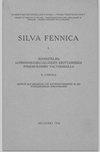Predicting factual sawlog volumes in Scots pine dominated forests using airborne laser scanning data
IF 1.7
3区 农林科学
Q2 FORESTRY
引用次数: 5
Abstract
The aim in the study was to compare alternatives for the prediction of factual sawlog volumes using airborne laser scanning (ALS) data in Scots pine ( L.) dominated forests in eastern Finland. Accurate estimates of factual sawlog volume are desirable to ease the planning of harvesting operations. The factual sawlog volume of pines was derived from visual bucking, i.e. a procedure where the defects were located on each stem during sample plot measurements. For other species, the theoretical sawlog volume was considered also as the factual sawlog volume due to data restrictions. We predicted factual sawlog volume with eight alternatives that were based on either linear mixed-effects models or k-nearest neighbour imputations. An existing sawlog reduction model, commonly used in Finland, was also tested individually and combined with a number of the alternatives, and site type information was also utilised. Model fitting and prediction was implemented at the 15 Ã 15 m level, but accuracy was assessed at the 30 Ã 30 m level. The relative root mean squared error (RMSE%) values for the factual sawlog volume predictions varied between 20.9% and 33.5%, and the best accuracy was obtained with a linear mixed-effects model. These results indicate that factual sawlog volumes in Scots pine dominated forests can be predicted with reasonable accuracy with ALS data.Pinus sylvestris利用机载激光扫描数据预测苏格兰松林的实际锯木量
本研究的目的是比较在芬兰东部以苏格兰松(L.)为主的森林中使用机载激光扫描(ALS)数据预测实际锯木量的替代方案。对实际锯木量的准确估计对于简化采伐作业的规划是可取的。松树的实际锯木体积来源于视觉屈曲,即在样本地块测量期间,缺陷位于每个茎上的程序。对于其他物种,由于数据的限制,理论锯材体积也被认为是事实锯材体积。我们使用基于线性混合效应模型或k近邻imputations的八种替代方法预测了实际锯木量。芬兰常用的现有锯木减少模型也分别进行了测试,并与许多替代方案相结合,还利用了场地类型信息。模型拟合和预测在15 ×15 m水平进行,但精度在30 ×30 m水平进行评估。实际锯木体积预测的相对均方根误差(RMSE%)值在20.9% ~ 33.5%之间,线性混合效应模型的准确度最高。这些结果表明,利用ALS数据可以较准确地预测苏格兰松林的实际锯木量。抗旱性
本文章由计算机程序翻译,如有差异,请以英文原文为准。
求助全文
约1分钟内获得全文
求助全文
来源期刊

Silva Fennica
农林科学-林学
CiteScore
3.50
自引率
11.10%
发文量
21
审稿时长
3 months
期刊介绍:
Silva Fennica publishes significant new knowledge on forest sciences. The scope covers research on forestry and forest ecosystems. Silva Fennica aims to increase understanding on forest ecosystems, and sustainable use and conservation of forest resources. Use of forest resources includes all aspects of forestry containing biomass-based and non-timber products, economic and social factors etc.
 求助内容:
求助内容: 应助结果提醒方式:
应助结果提醒方式:


